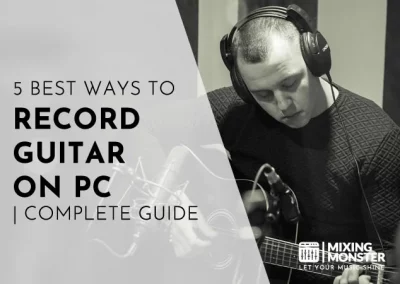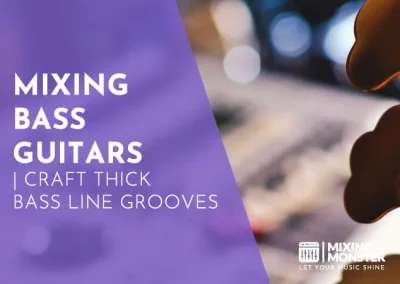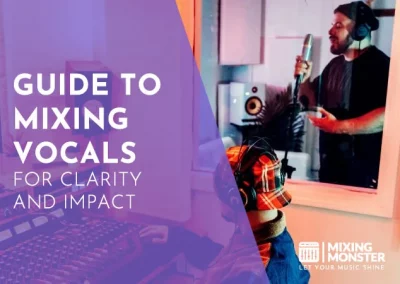Home > Blog > Mixing > Mixing Instruments
Disclosure: Some of the links below are affiliate links, meaning that at no additional cost to you, we will receive a commission if you click through and make a purchase. Read our full affiliate disclosure here.
Mixing acoustic guitars is a critical step in music production that shapes the character and clarity of the guitar within a track. Whether the acoustic guitar is a lead instrument or a complementary texture, its mix can profoundly impact the song’s overall feel. It’s essential to understand the instrument’s frequency range and how it fits within a song’s arrangement to achieve the ideal mix for an acoustic guitar.
The acoustic guitar has a wide frequency response, with important sonic details in the lows, mids, and highs. When mixed correctly, an acoustic guitar should sound full and rich in a sparse arrangement. In contrast, it may need to sit comfortably in the background in a busier mix, providing rhythm without overpowering other elements. Techniques such as EQ adjustments, dynamic processing, and spatial effects like reverb and delay play significant roles in crafting the guitar’s final sound.
Exploring various recording techniques and mixing processes will equip you with the skills to achieve polished, professional-sounding acoustic guitar tracks. Whether you want to create a subtle, natural ambiance or a more pronounced, effect-laden presence, this article will provide valuable insights and practical advice to guide your mixing journey.
KEY TAKEAWAYS:
- Adequate mixing of acoustic guitars shapes their role in a song.
- EQ adjustments and dynamic processing are crucial techniques.
- Varying recording methods and effects enhance the guitar’s mix.
Table Of Contents
1. Basics Of Mixing Acoustic Guitars
2. Acoustic Guitar Recording Techniques
3. The Role Of EQ In Mixing Acoustic Guitars
4. Dynamic Processing Of Acoustic Guitars
5. Using Reverb And Delay When Mixing Acoustic Guitars
6. Creating The Right Acoustic Guitar Balance
7. Stereo Imaging And Panning In Mixing Acoustic Guitars
8. Enhancing The Acoustic Guitar Mix With Effects
9. Finalizing The Acoustic Guitar Mix
10. Key Takeaways For Mixing Acoustic Guitars
11. FAQ

1. Basics Of Mixing Acoustic Guitars
When mixing acoustic guitars, understanding their structural characteristics, recognizing the distinct sonic qualities of different types, and defining their role in a mix are foundational to achieving a sound that complements your track.
Anatomy Of The Acoustic Guitar
The acoustic guitar has various components that influence its sound. When played, the strings vibrate at varying frequencies, producing distinct tones and harmonics. The guitar’s body acts as a resonating chamber, amplifying these vibrations and adding richness to the sound.
When mixing, you must consider how these elements—strings, body, and neck—affect the tone and presence of the guitar in your mix.
Differences In Acoustic Guitar Types
Different types of acoustic guitars—such as the dreadnought, concert, and jumbo—bring divergent qualities to a mix. For example, a battleship typically offers a robust low-end that can fill a mix, whereas a concert might provide a brighter and more balanced tone.
You should choose EQ settings that enhance the natural overtones and character of the specific guitar you’re working with.
The Role Of Acoustic Guitars In A Mix
Acoustic guitars’ roles in a mix vary greatly depending on the genre and the desired effect. They can either be a central rhythmic force or provide a subtle layer of texture.
It’s important to shape the guitar’s tone to support the harmony without overshadowing other instruments or vocals. Remember to carve space in the mix for the guitar’s fundamental frequencies and harmonics to ensure clarity and avoid muddiness.
2. Acoustic Guitar Recording Techniques
When recording acoustic guitars, the clarity and quality of the sound capture depend heavily on your choice and use of microphones and the room’s acoustics. Proper technique in both areas can significantly enhance your production.
Microphone Selection And Placement For Recording Acoustic Guitars
Microphone Selection
Your choice of microphone can significantly impact the acoustic guitar’s recorded tone. Large-diaphragm condenser microphones are widely used because they can capture the full frequency range and subtle nuances of the guitar.
However, small-diaphragm condenser microphones are preferred for their detail and consistency, particularly in capturing the brightness of the strings and subtleties of finger movement.
Microphone Placement
The microphone’s position determines the balance between the brightness and the body of the guitar’s tone. A typical starting point is placing the microphone 6 to 12 inches away from the 12th fret to avoid direct sound from the soundhole, which can lead to a boomy recording. Precise placement can vary based on the desired sound:
-
- Near The Sound Hole:
Richer lows, but the risk of boominess. - Near The 12th Fret:
Balanced sound that captures the strings and the body’s resonance. - Stereo Recording:
Two microphones can capture a richer, more spatial sound. Be mindful of phase issues that can affect the recorded track’s fullness.
- Near The Sound Hole:
Dealing With Room Acoustics
The room you record in contributes to the ‘room tone’ and can add desirable (or undesirable) character to your recordings. To ensure the quality of your tracking environment:
- Room Size And Surfaces:
A smaller room can make for a tighter sound, but be wary of reflective surfaces that may cause flutter echoes or a boxy sound. Treating the room with acoustic panels or even temporary solutions such as hanging blankets can dampen these reflections. - DI Box Usage:
Consider using a DI box to record the acoustic guitar when unwanted room acoustics are an issue or a clean, direct signal is preferred. The DI box lets you capture the guitar directly into your production setup without the room’s coloration, offering a pure and noise-free signal that can benefit a mix.
3. The Role Of EQ In Mixing Acoustic Guitars
EQ is critical when mixing acoustic guitars to ensure clarity and warmth in the track. Applying the proper EQ techniques can sculpt the tone to enhance the guitar’s natural sound without compromising its authentic characteristics.
Subtractive And Additive EQ Techniques
When approaching EQ for acoustic guitars, you have two main strategies: subtractive and additive EQ. Subtractive EQ involves removing unwanted frequencies to clean up the sound, which can help eliminate muddiness, particularly in the low-mids. On the other hand, additive EQ can be used to boost specific frequencies to enhance characteristics like resonance and air.
A common technique is to use a high-pass filter to remove the low end that is unnecessary for an acoustic guitar’s sound profile. This can prevent the guitar from competing with the bass frequency range of other instruments or the mix as a whole.
EQ Settings For Clarity And Warmth
EQ settings are pivotal in achieving clarity and warmth in an acoustic guitar. To bring out the guitar’s sparkle, gently boosting around the high-end frequencies can be effective. However, doing just what is necessary is important, as too much high-end can result in a brittle sound.
Ensure that the low mids are well-balanced to maintain the guitar’s warmth. A subtle boost can enrich the guitar’s body, but too much can lead to a boomy or muddy mix.
Common EQ Settings for Acoustic Guitar:
| Frequency Range | Purpose | Suggested Technique |
|---|---|---|
| Below 100 Hz | Remove rumble | High-pass filter |
| 100-200 Hz | Control boominess | Subtractive EQ |
| 200-400 Hz | Warmth in body | Subtle boost |
| 400-800 Hz | Reduce boxiness | Subtractive EQ |
| 1-4 kHz | Add bite and presence | Careful boost |
| Above 5 kHz | Increase air/sparkle | Additive EQ |
4. Dynamic Processing Of Acoustic Guitars
Dynamic processing is crucial for managing the varying levels in your acoustic guitar tracks, achieving a polished and balanced mix.
Acoustic Guitar Compression Essentials
Compression is a fundamental tool in shaping the dynamics of an acoustic guitar. When you apply compression, you aim to reduce the dynamic range—the difference between the loudest and quietest parts of the performance.
An important aspect to consider is the attack time, which determines how quickly the compressor starts to work after the signal exceeds the threshold. Set a slower attack if you wish to preserve the initial transients of the guitar strums, giving a more natural feel.
The release time dictates how soon the compression will cease once the signal falls below the threshold. A longer release time can smooth out the tail of the notes, while a shorter release time can help maintain natural dynamics.
The ratio will determine the intensity of the compression. For most acoustic guitars, a lower ratio, such as 2:1 or 3:1, often suffices, ensuring a gentle and transparent compression that maintains the integrity of the original performance.
Controlling Acoustic Guitar Dynamics With Gain Reduction
Gain Reduction refers to the amount by which the compressor reduces the signal. It shows how much compression is being applied to the signal. Gain reduction allows you to control spikes in volume without affecting the parts at an appropriate level.
Aim for a mild gain reduction level using a compressor, typically around -3dB to -6 dB. This ensures the natural dynamics of the acoustic guitar are preserved. This gentle approach keeps the strumming coherent and avoids an over-processed sound.
Here’s a table summarizing common compression settings tailored for acoustic guitars:
| Setting | Value | Purpose |
|---|---|---|
| Threshold | Variable | Sets the level at which compression begins. |
| Ratio | 2:1 to 3:1 | Provides gentle compression without over-squashing. |
| Attack Time | 10ms to 30ms | Preserves natural attack and maintains transient details. |
| Release Time | 40ms to 100ms | Controls how quickly the compression stops affecting the signal. |
| Gain Reduction | -3dB to -6dB | Reduces peaks for a more consistent performance level. |

5. Using Reverb And Delay When Mixing Acoustic Guitars
When mixing acoustic guitars, the proper use of reverb and delay can add remarkable depth and bring a vintage vibe to your track. These tools give you control over the sense of space and room tone, enhancing the natural qualities of the guitar.
Achieving Depth And Space
Adjusting reverb settings can create depth and space in your acoustic guitar mix. Plate reverb can provide smooth decay, perfect for creating a classic shimmer.
To maintain clarity, start with short decay times and a moderate mix level to prevent the reverb from overwhelming the guitar’s natural sound. Add a touch of air to the tail of the reverb to help the guitar sit comfortably in the mix without feeling too distant.
Using Reverb And Delay In Mixing Acoustic Guitars
Use the effect tastefully when integrating delay to avoid muddying the guitar’s articulation. Depending on your chosen timing, a slap-back delay can inject a vintage character or a rhythmic feel.
Make sure the delay is subtle and complements the track’s tempo.
Below is a table of common reverb types and settings that could be effective when mixing acoustic guitars:
| Reverb Type | Predelay (ms) | Decay Time (s) | Mix Level (%) | Notes |
|---|---|---|---|---|
| Plate | 10-30 | 1.2-2 | 20-30 | Classic shimmer, smooth tail |
| Room | 0-10 | 0.4-1.5 | 10-20 | Natural ambiance, good for small space emulation |
| Hall | 20-50 | 1.5-3 | 15-30 | Expansive sound, can simulate large concert spaces |
| Spring | 5-20 | 1.0-2 | 20-40 | Vintage vibe with a distinctive ‘boingy’ character |
To blend your acoustic guitar successfully into the mix using these effects, adjust the settings based on the context of the piece and the overall feel you’re aiming for. Experimenting with reverb and delay will allow you to flesh out the guitar’s presence in the mix, giving it space to breathe and enhancing its role in the overall sound landscape.
6. Creating The Right Acoustic Guitar Balance
Achieving the perfect balance for an acoustic guitar in the mix is crucial for clarity and harmony in your track. You aim to harmonize the guitar with vocals and other instruments while avoiding low-end mud and preserving each element’s characteristics.
Balancing Acoustic Guitars With Vocals
When mixing acoustic guitar with vocals, your primary task is to ensure neither overshadows the other. Start by adjusting the acoustic guitar levels—in a sparse mix, the guitar should be audible but not dominate the vocals.
Use EQ to carve out a space for both. Consider a high-pass filter to eliminate mud from the guitar’s low end, and apply gentle cuts or boosts to accentuate the vocals without conflicting frequencies.
- Level Setting:
Adjust the acoustic guitar’s level to complement the vocal’s volume. - EQ Tweaks:
Apply EQ to enhance the clarity between the guitar and vocals.
Mixing Acoustic Guitars With Other Instruments
Integrating acoustic guitars with other instruments is a delicate task. Start by panning to create space in the mix and using EQ to reduce frequency clashes. Give enough room for bass instruments to ensure the low end doesn’t get muddy.
Compression can help maintain a consistent level for the guitar, but be careful not to squash its dynamic range. Judge the balance while listening to the full arrangement to find the sweet spot.
- Panning:
Utilize panning to position the guitar in the stereo field. - EQ And Compression:
Apply EQ for clarity and compression for consistent levels. - Contextual Mixing:
Adjust balance while listening to the full arrangement for integration.
7. Stereo Imaging And Panning In Mixing Acoustic Guitars
Creating a captivating stereo image in your acoustic guitar mix is crucial. You can give your guitars precise spatial placement and enhanced width through strategic panning, providing a full-bodied listening experience.
Establishing A Stereo Field For Acoustic Guitars
When you mix acoustic guitars, think of the stereo field as a canvas where you’ll place different sound elements. Your primary goal is to use this canvas to create a sense of depth and space.
A wide stereo image can be achieved by recording with multiple microphones and placing them in various positions relative to the guitar. This creates a natural spread in the sound, where each microphone picks up different nuances of your guitar’s tone.
- Single Guitar:
You might place a single guitar slightly off-center to avoid clashes with other mid-channel elements like vocals. - Multiple Guitars:
If you’re working with multiple acoustic guitars, assign each one a unique spot within the stereo field to prevent frequency overlap and create a more immersive sound.
Panning Acoustic Guitars For Width And Placement
Panning is a tool for placing your acoustic guitar within your established stereo field. You can manipulate panning to control the listener’s perception of where the guitar sits relative to other instruments.
- Hard Panning:
For a wider sound, you might pan one guitar hard left and another hard right, especially if they’re playing different parts or if you’re using a double-tracking technique. - Subtle Panning:
Position acoustic guitars closer to the center for a more nuanced and natural effect, perhaps panned to 10 or 2 o’clock. This panning method can keep your mix more balanced and maintain the guitar’s presence without overly dominating one side of the stereo field.
Remember, panning decisions should always serve the song and the feeling you want to convey with your acoustic guitar mix.
8. Enhancing The Acoustic Guitar Mix With Effects
Applying effects to the acoustic guitar can profoundly shape its tone and presence in a mix. You’ll discover how to skillfully use modulation for depth and creative effects and integrate distortion and saturation to add unique character.
Utilizing Modulation And Creative Effects
Modulation effects like chorus and phasing can add richness and movement to your acoustic guitar tracks. When used with discretion, a chorus effect can make the guitar sound fuller and give it a slight growth that helps it stand out. Here’s a brief guide on utilizing these effects:
- Chorus:
Apply subtly to avoid drowning out the instrument’s natural tone. Aim for a setting that enhances, not overwhelms. - Phaser/Flanger:
Use these to create a mild swirling effect, particularly in sections where the guitar needs to shine without overpowering other elements.
Experiment with the rate and depth controls to find the sweet spot that complements the track.
Tasteful Application Of Distortion And Saturation
Distortion and saturation can be a double-edged sword. It would help if you wielded them to introduce warmth and grit, heightening the guitar’s character rather than overpowering it harshly. Here’s how to implement them properly:
- Light Saturation:
It can subtly increase the guitar’s presence—like turning up the heat just enough to give it a comforting warmth. - Mild Distortion:
Offering a bit of edge, mild distortion can help the guitar cut through a dense mix, especially during a dynamic part of the song.
Both saturation and distortion are powerful tools that necessitate a controlled approach. Listen critically to ensure these effects contribute positively to the overall sound of your mix.
9. Finalizing The Acoustic Guitar Mix
Finalizing your acoustic guitar mix involves critical listening and adjustments to ensure mono compatibility and professional sound quality. Your goal is to maintain the power and clarity of the guitar tracks within the context of the full mix.
Checking Acoustic Guitar Phase And Mono Compatibility
Mono compatibility is vital, as your mix may be played on systems that sum stereo to mono. Check the phase by flipping the phase switch and listening for changes in power and fullness.
Phase issues may occur if the acoustic guitar tracks lose low-end or sound thin. You can rectify this by adjusting the microphone positions or using phase alignment tools during recording or mixing.
- Listen In Mono:
Sum your mix to mono and listen for tonal balance and phase cancellation. - Adjust And Test:
If there are phase issues, realign your guitar tracks and test again.
Using Reference Tracks For A Professional Acoustic Guitar Sound
Reference tracks can guide you toward a professional sound. Select a professionally mixed track with an acoustic guitar that resonates with your mixing goals.
- A/B Comparing:
Alternate between your mix and the reference track. Listen critically to the acoustic guitar’s EQ balance, stereo image, and level against other instruments. - Match Tones:
Try to match the reference track’s tonal balance and dynamics without losing your guitar track’s unique character.
You’ll ensure your acoustic guitar mix competes with professional standards by carefully checking phases and using reference tracks.
10. Key Takeaways For Mixing Acoustic Guitars
The success of your acoustic guitar tracks in a mix hinges on attention to detail and a few critical techniques.
Mixing Acoustic Guitars Like A Pro
- Levels And Panning:
Set a balanced level for your acoustic guitar. Aim to position it in the stereo field, where it complements the vocal without overwhelming it. - EQ:
Apply EQ judiciously to enhance the guitar’s natural sound. Cut unnecessary low frequencies to reduce mud and boost where the guitar shines to help it stand out clearly. - Compression:
Use compression to control dynamics while preserving the natural character of your guitar’s performance. Please set it to tame peaks without squashing the life out of the strums and picks. - Reverb And Effects:
Add a touch of reverb for spatial dimension, but avoid over-processing that could muddy your guitar. Subtle effects can add character and distinction. - Listen In Context:
Always adjust your guitar’s mix settings while listening to the full arrangement. Soloing the guitar can mislead your mix decisions.
Key Takeaways or Mixing Acoustic Guitars:
- Balance the guitar’s level with vocals for clarity.
- Cut lows and enhance characteristic frequencies with EQ.
- Compress gently to manage dynamics without losing nuance.
- Utilize reverb sparingly; avoid overusing effects.
- Make adjustments in the context of the full mix, not in isolation.
Happy acoustic guitar mixing!
11. FAQ
1) How can you achieve a natural sound when mixing an acoustic guitar?
To achieve a natural sound, you should focus on minimal processing and careful EQ to bring out the instrument’s true tone. Techniques like subtle compression and mic placement during recording can also preserve the acoustic’s qualities.
2) What are some effective acoustic guitar mixing techniques for live performances?
Ensure the guitar cuts through the mix for live performances without overwhelming other instruments. Use a high-pass filter to remove low-end rumble and strategic boosts in the mid-frequencies to maintain clarity and presence in a busy live mix.
3) Which reverb settings are recommended for acoustic guitars in a mix?
A small to medium room reverb can enhance the acoustic guitar’s warmth without making it sound distant. Dial in the reverb so it complements the guitar’s body and doesn’t wash out the articulate details.
4) How do you balance acoustic guitar and vocals when mixing?
Balancing acoustic guitar and vocals involves adjusting EQ frequencies to avoid clashes. Carve out space for each by attenuating competing frequencies, ensuring both elements are heard clearly without overpowering the other.
5) What is an optimal acoustic guitar mixing chain for clarity?
An optimal mixing chain for clarity might include EQ to sculpt the tone, gentle compression to even out dynamics, a de-esser to tame harsh high frequencies, and subtle saturation to add harmonics and presence.
6) In a stereo mix, how should you position an acoustic guitar?
Panning the acoustic guitar slightly off-center in a stereo mix can create a spacious soundstage while maintaining balance. The exact position depends on the mix’s complexity and the presence of other competing instruments.


















